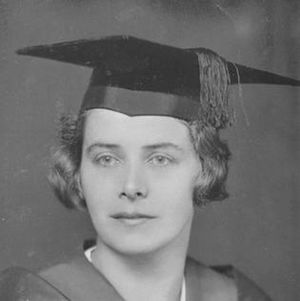Emily Dix facts for kids
Quick facts for kids
Emily Dix
|
|
|---|---|
 |
|
| Born | 21 May 1904 |
| Died | 31 December 1972 |
| Nationality | British |
| Alma mater | University of Wales |
| Scientific career | |
| Fields | Paleobotany |
| Institutions |
|
| Thesis | On the correlation of coal seams in South Wales (1933) |
| Academic advisors | Arthur Trueman |
Emily Dix (born May 21, 1904 – died December 31, 1972) was an important British scientist. She was a palaeobotanist, which means she studied ancient plants from fossils. Emily Dix was especially interested in the fossil plants found in areas where coal was formed.
Contents
Becoming a Scientist
Emily Dix grew up on a farm in Llanrhidian, on the Gower Peninsula in Wales. When she was 18, she won a special scholarship. This scholarship allowed her to attend University College Swansea.
University Studies
In 1925, Emily graduated with top honors in geology. Geology is the study of Earth's solid features, rocks, and how they change over time. After graduating, she continued her studies at Swansea. She worked closely with her professor, Arthur Trueman, for five years.
Advanced Degrees
Emily earned her Master of Science (M.Sc.) degree in 1926. Her research focused on ancient life forms found in the Coal Measures of the Gwendraeth Valley in South Wales. The Coal Measures are layers of rock that contain coal. In 1933, she received her Doctor of Science (D.Sc.) degree. Her doctorate research was about connecting different coal layers in South Wales. The government supported her work with grants. This was because her research was very important for the coal industry.
Her Career in Science
In 1929, Emily Dix was chosen as a Fellow of the Geological Society. This is a special honor for geologists. In 1930, she became a lecturer in geology at Bedford College in London. She taught there for the rest of her working life.
Key Research Contributions
Emily's early work looked at ancient freshwater clams and mussels in the South Wales Coalfield. She continued to study these throughout her career. Her biggest contribution was using Professor Trueman's methods to study plant fossils. This helped her understand the layers of rock better. This method is called biostratigraphy.
Sharing Her Discoveries
Emily shared her research at international meetings. One important meeting was the Second International Carboniferous Congress in the Netherlands in 1935. In 1936, she received the Murchison Fund award. This award from the Geological Society of London recognized her work. She combined evidence from both plant and animal fossils. This helped improve understanding of the Upper Carboniferous rock layers. This information was useful for both science and the coal industry.
Impact of World War II
World War II happened when Emily's career was at its peak. The war made it difficult for her to continue her scientific work. Bedford College was moved to Cambridge for safety. Sadly, her fossil collections and scientific papers were left behind. They were later lost due to bombing. After the war, Bedford College returned to London in 1944. Emily led a field trip for geologists in 1945.
Later Life
Towards the end of the war, Emily Dix faced health challenges. These challenges led to the end of her scientific career. By 1946, her health had declined. She was cared for by her sister, Margaret. Emily spent her later years in hospitals, first in York and then in Carmarthen, Wales, until her death.
Her Scientific Legacy
Most of Emily Dix's valuable fossil collections survived. Today, her fossils are kept in several museums. These include the Hunterian Museum in Glasgow. Others are at Amgueddfa Cymru - National Museum of Wales in Cardiff. The Sedgwick Museum in Cambridge also holds parts of her collection. Her work continues to help scientists understand ancient plant life and coal formation.

